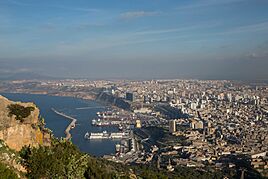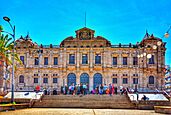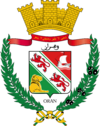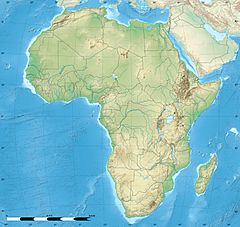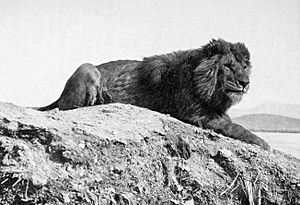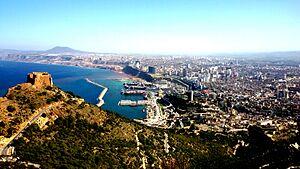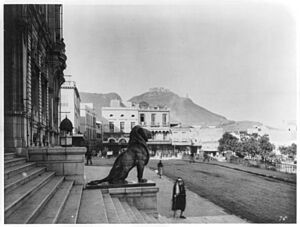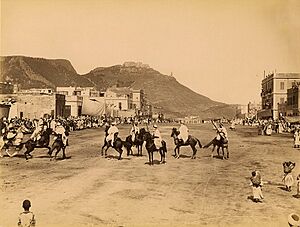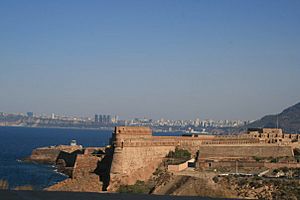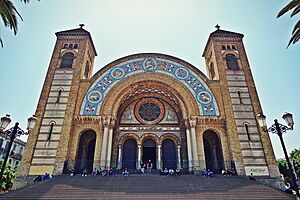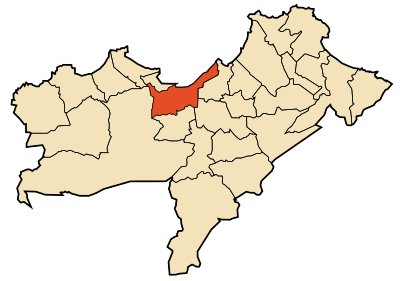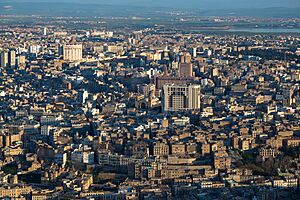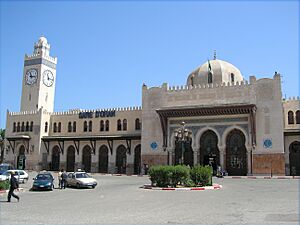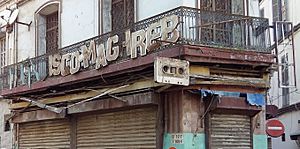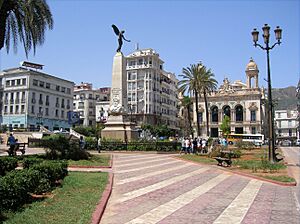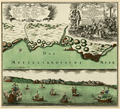Oran facts for kids
Quick facts for kids
Oran
وهران
Wahrān
|
||
|---|---|---|
|
City
|
||
|
From top, left to right: general view of Oran's port, Mobilar towers, Oran city hall, Sacred Heart Cathedral, Sheraton Hotel, Santa-Cruz chapel and Abdelhamid Ben Badis Mosque
|
||
|
||
| Nickname(s):
al-Bāhia الباهية
|
||
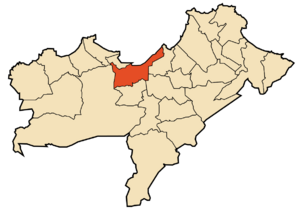 |
||
| Country | ||
| Province | Oran Province | |
| District | Oran District | |
| Re-founded | AD 944 | |
| Area | ||
| • City | 2,121 km2 (819 sq mi) | |
| Elevation | 0.9 m (3 ft) | |
| Population
(2008 for city proper, 2019 for metro area)
|
||
| • City | 803,329 |
|
| • Metro | 1,570,000 | |
| Demonym(s) | Wahrani | |
| Time zone | UTC+1 (CET) | |
| Postal codes |
31000 - 31037
|
|
Oran (Arabic: وَهران, romanized: Wahrān) is a big city on the coast in northwest Algeria. It's the second most important city in Algeria, after the capital, Algiers. This is because of its large population and its importance for business, industry, and culture. Oran is about 432 km (268 mi) west-southwest of Algiers. In 2008, the city had a population of 803,329 people. The larger area around the city has about 1.5 million people, making it the second-largest city in Algeria.
Contents
- What's in a Name?
- Oran's Long History
- Geography and Climate
- City Areas
- Oran's Surrounding Areas
- Getting Around Oran
- Sports in Oran
- Culture and Fun
- Oran in Books and Movies
- Economy and Tourism
- Cities Oran is Connected To
- Famous People from Oran
- Images for kids
- See also
What's in a Name?
The name Wahran comes from an old Berber phrase, wa - iharan. This means "place of lions." A popular local story says that around the year 900 AD, Barbary lions were seen in this area. The last two lions were supposedly killed on a mountain near Oran. Because of this, the mountain became known as "The Mountain of Lions." Today, you can see two huge lion statues in front of Oran's city hall. They are a symbol of the city's name and history.
Oran's Long History
Early Times
Long ago, during the Roman Empire, there was a small settlement called Unica Colonia where Oran is now. But this settlement disappeared. The area was then taken over by different groups. First came the Vandals in 435 AD. Then, the Berbers ruled, and finally, the Arabs arrived around the early 700s.
The city of Oran as we know it was started in 903 AD. It was founded by Berber groups called the Azdadja and Ajissa. Oran became very successful under the Almohad leader Abd al-Mu'min. He built many ships to connect the city with Spain. Later, under the Zayyanid rulers of Tlemcen, Oran's ports were very important for trade with Spain.
Changing Rulers
In 1509, the Spanish, led by Cardinal Cisneros, captured Oran. Spain ruled the city until 1708. Then, Algerians took control during a siege. Spain got the city back in 1732. But by then, Oran was not as important for trade. So, in the late 1700s, Algerian troops fought against Spain again. They won, and Oran became part of the Beylik of Oran. This lasted until 1831, when the French took over.
French Rule and World War II
Under French rule (1831-1962), Oran was the capital of a region. During World War II, in July 1940, the British navy attacked French warships in Oran's port. This happened because the French ships refused to surrender to the British. The British wanted to stop the ships from falling into German hands. Later, in 1942, the Allies captured Oran during Operation Torch.
During French rule, many Europeans moved to Oran. By the early 1900s, they made up most of the city's population.
After Independence
Before Algeria became independent in 1962, Oran had a very high number of Europeans. After a ceasefire and agreements with France, the FLN entered Oran. Sadly, there was violence, and many people were killed. This led to a large number of Europeans and Algerian Jews leaving Oran and moving to France. In just a few months, Oran lost about half of its population.
Today, Oran is a major port and a busy business center. It has three universities. The old part of Oran has a casbah (an old fortress or city) and a mosque from the 1700s. The newer part of Oran, called La Ville Nouvelle, was built after 1831.
Religious History in Oran
Because Oran was close to Spain and important for trade, many Jewish refugees came here. They were trying to escape being forced to convert to Christianity in Spain, starting in 1391. Later, in 1492 and 1502, more Jewish and Muslim refugees arrived. In 1870, under French rule, Algerian Jews were given French citizenship. After Algeria became independent in 1962, many Jewish people left Oran. In 1975, the Great Synagogue of Oran was turned into a mosque.
Oran Under Different Islamic Dynasties (910–1509)
Oran was often a place of conflict between different ruling groups.
- From 910 to 1082, the city was fought over by the Umayyads from Spain and the Fatimids from Kairouan.
- From 1082 to 1145, the Almoravids were present. In 1145, their leader Tashfin ibn Ali died near Oran while trying to escape Almohad troops.
- From 1145 to 1238, the Almohads ruled. During this time, there was a period of persecution for Oran's Jewish population.
- From 1238 to 1509, the Zianides of Tlemcen ruled. Oran became very rich from trade with cities like Marseilles, Genoa, and Venice. A famous historian, Ibn Khaldoun, wrote that Oran was a "paradise" for those seeking wealth. The city was known for exporting lead, wool, skins, carpets, and spices.
Spanish Rule (1509–1708, 1732–1792)
Before the Spanish, the Portuguese tried to capture Oran in 1501 but failed. In 1505, the Spanish took Mers-el-Kébir, a port near Oran. Then, in 1509, Spanish forces led by Count Pedro Navarro captured Oran. They even burned many of the town's books and archives.
In 1563, the Spanish built the Fort of Santa-Cruz. This fort was placed high on a mountain, over 300 meters (1,000 ft) above the sea, to protect the city. The Spanish governor lived in a central castle called a kasbah. Oran continued to grow under Spanish rule, and its city walls had to be made bigger. Even with strong defenses, the city was attacked many times.
In 1669, the Spanish governor made all the Jewish people living in Oran and Mers El Kébir leave. They were sent to other cities like Nice or Livorno.
Beylikal Period (1708–1732, 1792–1831)
The Spanish ruled Oran until 1708. Then, Mustapha Ben Youssef, the Bey (ruler) of Mascara, took advantage of a war in Spain and drove the Spanish out.
However, in 1732, Spanish forces returned and captured the city again. Spain held Oran for another 60 years.
In 1790, a strong earthquake hit Oran, killing over 3,000 people. The Spanish king, Charles IV, decided it was too expensive and dangerous to keep the city. He made a deal with the Dey (ruler) of Algiers.
Siege of Oran (1790–1792)
After another earthquake damaged the Spanish defenses, the new Bey of Oran, Mohammed el Kebir, surrounded the city. By late 1790, the Algerians had a clear advantage. Spain agreed to give control of the city to Algeria. By February 1792, all Spanish troops had left. The Bey moved his capital to Oran that same year. In 1796, the Pasha Mosque was built in Oran. It was paid for with money from freeing Spanish prisoners.
French Period (1831–1962)
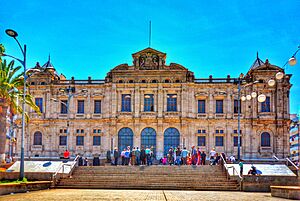
In 1830, French forces captured the nearby port of Mers el-Kébir. On January 4, 1831, the French, led by General Damrémont, took control of Oran. Many Europeans moved to Oran during this time. By the early 1900s, they made up most of the city's population.
During World War II, in November 1942, Oran was one of the landing spots for Operation Torch. This was the first time American forces took action in the Europe-North Africa area. Oran surrendered after heavy fighting.
Since Independence (1962)
After Algeria gained independence, many Europeans left Oran. Because of this, the Cathédrale du Sacré-Cœur d'Oran (Sacred Heart Cathedral) was turned into a public library in 1984.
Today, Oran is a busy port and a center for business. It has three universities. The old part of Oran has a casbah and a mosque from the 1700s. The modern part of Oran, called La Ville Nouvelle, was built after 1831. It looks very different from the older section, La Blanca.
Geography and Climate
Oran's Climate
Oran has a hot semi-arid climate. This means it's generally hot and dry. While it has some features of a Mediterranean climate, it doesn't get enough rain to be fully Mediterranean. Oran gets about 326 mm (12.8 inches) of rain each year. Most of this rain falls between November and May.
Summers are the hottest time, with average high temperatures in August reaching about 32 degrees Celsius (90°F). Winters are cooler, with high temperatures in January around 17 degrees Celsius (63°F).
| Climate data for Oran (Ahmed Ben Bella Airport) (1991–2020, extremes 1886–present) | |||||||||||||
|---|---|---|---|---|---|---|---|---|---|---|---|---|---|
| Month | Jan | Feb | Mar | Apr | May | Jun | Jul | Aug | Sep | Oct | Nov | Dec | Year |
| Record high °C (°F) | 28.4 (83.1) |
33.0 (91.4) |
36.6 (97.9) |
37.9 (100.2) |
40.0 (104.0) |
42.2 (108.0) |
46.3 (115.3) |
43.0 (109.4) |
41.1 (106.0) |
40.4 (104.7) |
33.0 (91.4) |
30.8 (87.4) |
46.3 (115.3) |
| Mean daily maximum °C (°F) | 17.0 (62.6) |
17.9 (64.2) |
20.1 (68.2) |
22.1 (71.8) |
25.0 (77.0) |
28.5 (83.3) |
31.5 (88.7) |
32.4 (90.3) |
29.4 (84.9) |
26.0 (78.8) |
20.9 (69.6) |
17.9 (64.2) |
24.1 (75.4) |
| Daily mean °C (°F) | 11.2 (52.2) |
12.2 (54.0) |
14.4 (57.9) |
16.5 (61.7) |
19.5 (67.1) |
23.0 (73.4) |
25.9 (78.6) |
26.7 (80.1) |
23.8 (74.8) |
20.2 (68.4) |
15.4 (59.7) |
12.4 (54.3) |
18.4 (65.1) |
| Mean daily minimum °C (°F) | 5.4 (41.7) |
6.5 (43.7) |
8.7 (47.7) |
10.8 (51.4) |
14.0 (57.2) |
17.6 (63.7) |
20.4 (68.7) |
21.0 (69.8) |
18.3 (64.9) |
14.4 (57.9) |
9.8 (49.6) |
6.9 (44.4) |
12.8 (55.0) |
| Record low °C (°F) | −2.9 (26.8) |
−3.3 (26.1) |
−1.3 (29.7) |
1.0 (33.8) |
3.0 (37.4) |
9.5 (49.1) |
11.5 (52.7) |
10.0 (50.0) |
7.8 (46.0) |
1.2 (34.2) |
1.0 (33.8) |
−2.0 (28.4) |
−3.3 (26.1) |
| Average precipitation mm (inches) | 46.3 (1.82) |
41.7 (1.64) |
37.6 (1.48) |
35.7 (1.41) |
23.1 (0.91) |
3.5 (0.14) |
0.8 (0.03) |
2.4 (0.09) |
17.4 (0.69) |
34.4 (1.35) |
64.6 (2.54) |
47.9 (1.89) |
355.4 (13.99) |
| Average precipitation days (≥ 1.0 mm) | 6.3 | 5.6 | 5.0 | 4.7 | 3.1 | 0.9 | 0.2 | 0.5 | 2.6 | 4.4 | 6.6 | 5.7 | 45.6 |
| Average relative humidity (%) | 80 | 77 | 74 | 73 | 69 | 70 | 69 | 68 | 72 | 75 | 77 | 78 | 73 |
| Mean monthly sunshine hours | 194.1 | 200.5 | 238.1 | — | 303.8 | 323.8 | 337.0 | 319.9 | 260.7 | 237.7 | 194.3 | 184.2 | — |
| Source 1: NOAA | |||||||||||||
| Source 2: Deutscher Wetterdienst (humidity 1949–1967, records 1941–1970), Meteo Climat (records) | |||||||||||||
Earthquake Safety
Oran is in Northern Algeria, an area that can experience earthquakes. The last big earthquake was in 1790, which caused many deaths. Today, older buildings in the city have been made stronger. New buildings are designed to withstand earthquakes. This helps keep people safe.
City Areas
Since 2019, Oran has 18 main areas, called communal délégations, and 83 smaller neighborhoods. Here are a few important ones:
Medina Jedida
Medina Jedida means "new city" in English. It's a large, historic, and popular area. During the French colonial period, it was one of the main Muslim neighborhoods. It's home to one of the biggest markets in Algeria, called Le Marché de Medina Jedida.
El Hamri
El Hamri is a big and popular area in the center of Oran. It was known as Lamur during French rule. The famous football club Mouloudia d'Oran is located here.
Sidi El Houari
Sidi El Houari is a historic area in the north of Oran. You can find the Saint-Louis college and the old Pasha Mosque from the 1600s here. The patron saint of the city, Sidi El Houari, is buried in this district. Other interesting places include old Spanish ruins from the 1500s and the Palace of the Bey of Oran.
Oran's Surrounding Areas
The larger area around Oran includes several towns.
Mers El-Kébir
Mers El Kébir means "The Great Port." It's a town northwest of Oran, about 7 km (4.3 mi) from the city center. It's a very important port and has a big naval base for the Algerian Navy.
Aïn El-Turk
Aïn El Turk means "Fountain of the Turks." It's also northwest of Oran, about 15 km (9.3 mi) away. It's a seaside town with many hotels and places for tourists.
Es-Sénia
Es Sénia is south of Oran. It has industrial areas and several universities, like Oran-Es-Sénia University. The international airport is also located here.
Bir El-Djir
Bir El Djir is a growing area on the eastern side of Oran, about 8 km (5 mi) from the city center. It has a population of 118,000 people. Many important buildings are here, including a large hospital, a convention center, and the University of Sciences and Technology. There's also a big sports complex with an Olympic stadium built for the 2022 Mediterranean Games.
Misserghin
Misserghin is a small city located southwest of Oran.
Getting Around Oran
Oran has public transportation that includes a metro system for coastal areas and a tramway for the suburbs. There are also many taxis. A tramway line was completed in 2010. It has 31 stations and covers about 17.7 km (11 mi). It connects different parts of the city, including universities and the city center.
The Ahmed Ben Bella Airport, also known as Es-Senia Airport, serves Oran. It has flights within Algeria and to other countries, especially France. The airport is about 12 km (7.5 mi) from the city center. You can also reach Oran by ferry from ports in France and Spain.
Sports in Oran
Oran has a football (soccer) team called MC Oran.
The city held its first international marathon in 2005. Runners from many countries took part. Oran was also chosen to host the XIX Mediterranean Games in 2022, a big sports event for countries around the Mediterranean Sea.
Culture and Fun
The folk music style called Raï started in Oran. This music began in the 1930s and mixes Arab and European sounds. Many famous Raï musicians, like Cheb Hasni and Cheb Khaled, are from Oran. The famous fashion designer Yves Saint Laurent was also born in Oran.
Local Food
The traditional Algerian lemon sorbet called creponne was first made in Oran.
Oran in Books and Movies
Oran has been featured in many famous stories:
- Albert Camus' 1939 essay The Minotaur talks about life in Oran.
- Albert Camus' 1947 novel The Plague tells a fictional story about a doctor during a plague in Oran in the 1940s.
- El Gallardo Español (1615) by Miguel de Cervantes takes place in Oran. Cervantes also mentions the city in other works, including Don Quixote.
- In the movie Casablanca (1942), Oran is a stop for refugees trying to escape to the Americas.
- Part of Arturo Pérez-Reverte's novel, Corsarios de Levante (Pirates of the Levant, 2006), is set in Oran in the early 1600s.
- The TV series Hornblower features Lieutenant Hornblower being sent to Oran for supplies, only to find the city suffering from a plague.
- The main character of Geraldine Brooks' novel, Year of Wonders, moves to Oran after her village is quarantined due to the plague.
- Joann Sfar's graphic novel The Rabbi's Cat 2 starts in Oran.
- Kamel Daoud's novel The Meursault Investigation is set in a bar in Oran.
Economy and Tourism
Oran is a major trading center. It's important for the oil and gas industry, especially with the nearby port of Arzew and the company Sonatrach. Oran also hosted a big international conference on Liquefied Natural Gas in 2010, bringing many visitors and companies.
To welcome tourists, new hotels are being built. Oran has many hotels, from fancy to simple, and restaurants with Algerian food. Tourists can visit cinemas, art centers, the regional theater, and the National Museum Ahmed Zabana. The museum has natural history exhibits and art.
The Bey's Palace in Sidi al-Houari is another popular spot. It's an old Ottoman palace with beautiful Islamic architecture. The Great Mosque, built in 1796, is also a popular attraction.
Water Supply
Oran has sometimes struggled with water supply because it doesn't get much rain. The government has invested in projects to store more water. They also built a desalination plant, which turns seawater into fresh water. This has greatly improved the water supply for the city. Oran now gets its water from groundwater, surface water, and desalination plants.
Cities Oran is Connected To
Oran is twinned with many cities around the world. This means they have special friendly relationships and often work together on projects.
- Alicante, Spain
- Bizerte, Tunisia
- Bordeaux, France (2003)
- Cairo, Egypt
- Casablanca, Morocco (1999)
- Dakar, Senegal
- Durban, South Africa
- Elche, Spain
- Gdańsk, Poland
- Havana, Cuba
- Jeddah, Saudi Arabia
- Leicester, England (2001)
- Lyon, France
- Metz, France
- Oujda, Morocco
- Rangpur, Bangladesh
- Seoul, South Korea
- Sfax, Tunisia (1989)
- Strasbourg, France (2013)
- Toulon, France
- Zarqa, Jordan
Oran also has partnerships and cooperation with Strasbourg, France (since 2013).
Famous People from Oran
Many notable people have come from Oran:
- Kaddour Bekhloufi (1934–2019), international football player
- Miloud Mourad Benamara (born 1977), actor
- Jean Benguigui (born 1944), French Actor
- Pierre Bénichou (1938–2020), French journalist
- Sirat Boumediène (1947–1995), actor
- Hamou Boutlélis (1920–1957), nationalist fighter
- Albert Camus (1913–1960), French philosopher, author, and journalist
- Alain Chabat (born 1958), French actor, director, and TV presenter
- Étienne Daho (born 1956), French singer
- Habib Draoua (1914–2008), co-founder of the ALN football team
- Sidi El Houari (1350–1439), imam and patron saint of Oran
- Jean-Pierre Elkabbach (born 1937), French journalist
- Maurice El Mediouni (born 1928), pianist and composer
- Miloud El Mehadj (1909–2001), imam and writer
- Tayeb El Mehadj (1881–1969), imam
- Kader Firoud (1919–2005), professional footballer and manager
- Henri Fouques-Duparc (1903–1976), French politician and mayor of Oran
- Miloud Hadefi (1949–1994), international footballer and manager
- Abderrahmane Hadj-Salah (1928–2017), linguist
- Caïda Halima (1859–1944), famous business woman
- Cheb Hasni (1968–1994), Raï singer
- Blaoui Houari (1926–2017), singer-songwriter and conductor
- Khaled (born 1960), famous Raï singer
- Mustapha Moussa (born 1962), former boxer, first Algerian Olympic medalist
- Armand Mouyal (1925–88), French world champion fencer
- Ahmed Saber (1937–1969), singer-songwriter and actor
- Yves Saint Laurent (1936–2008), French fashion designer
- Henri Stambouli (born 1961), former footballer and manager
- Ahmed Wahby (1921–1993), singer-songwriter and conductor
- Ahmed Zabana (1926–1956), nationalist activist
- Belkacem Zeddour Mohamed Brahim (1923–1954), nationalist activist
Images for kids
See also
 In Spanish: Orán para niños
In Spanish: Orán para niños


